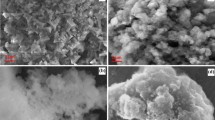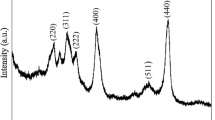Abstract
In order to investigate the mechanism of nanoparticles enhancing the heat and mass transfer of the ammonia-water absorption process, several types of binary nanofluids were prepared by mixing Al2O3 nanoparticles with polyacrylic acid (PAA), TiO2 with polyethylene glycol (PEG 1000), and TiN, SiC, hydroxyapatite (noodle-like) with PEG 10000 to ammonia-water solution, respectively. The thermal conductivities were measured by using a KD2 Pro thermal properties analyzer. The influences of surfactant and ammonia on the dispersion stabilities of the binary nanofluids were investigated by the light absorbency ratio index methods. The results show that the type, content and size of nanoparticles, the temperature as well as the dispersion stability are the key parameters that affect the thermal conductivity of nanofluids. For the given nanoparticle material and the base fluid, the thermal conductivity ratio of the nanofluid to the ammonia-water liquid increases as the nanoparticle content and the temperature are increased, and the diameter of nanoparticle is decreased. Furthermore, the thermal conductivity ratio increases significantly by improving the stabilities of nanofluids, which is achieved by adding surfactants or performing the proper ammonia content in the fluid.
Similar content being viewed by others
References
KANG Y T, KIM J, KIM J K. Comparisons of mechanical, chemical and nano technologies for absorption applications [C]// Proceedings of International Seminar on Thermally Powered Sorption Technology. Fukuoka, Japan, 2003: 69–77.
XU Jie, YU Bo-ming, ZOU Ming-qing, XU Peng. A new model for heat conduction of nanofluids based on fractal distributions of nanoparticles [J]. Journal of Physics D: Applied Physics, 2006, 39(20): 4486–4490.
EIYAD A N, ZIYAD M, HAKAN F. Effect of nanofluid variable properties on natural convection in enclosures [J]. International Journal of Thermal Sciences, 2010, 49(3): 479–491.
YANG Bao, HAN Zeng-hu. Thermal conductivity enhancement in water-in-FC72 nanoemulsion fluids [J]. Applied Physics Letters, 2006, 88(26): 261914.
LEE J K, KOO J, HONG H, KANG Y T. The effects of nanoparticles on absorption heat and mass transfer performance in NH3/H2O binary nanofluids [J]. International Journal of Refrigeration, 2010, 33(2): 269–275.
YANG Liu, DU Kai, ZHANG Xiao-song, CHENG Bo. Experimental study on enhancement of ammonia-water falling film absorption by adding nano-particles [J]. International Journal of Refrigeration, 2011, 34(3): 640–647.
CHOI S U S. Enhancing thermal conductivity of fluids with nano-particles [M]// Siginer D A, Wang H P. Development and Applications of Non-Newtonian Flows, EFD. New York: ASME, 1995: 99–105
KEBLINSKI P, PILLPOT S R, CHOI S U S, EASTMAN J A. Mechanism of heat flow in suspensions of nano-sized particles (nanofluids) [J]. Int J Heat Mass Transfer, 2002, 45(4): 855–863.
YOU S M, KIM J H, KIM K H. Effect of nano-particles on critical heat flux of water in pool boiling heat transfer [J]. Appl Phys Lett, 2003, 83(16): 3374–3376
KIM J, KANG Y T, CHOI C K. Analysis of convective instability and heat transfer characteristics of nanofluids [J]. Phys Fluids, 2004, 16(7): 2395–2401.
LI C H, PETERSON G P. Experimental investigation of temperature and volume fraction variations on the effective thermal conductivity of nanoparticles suspensions (nanofluids) [J]. Journal of Applied Physics, 2006, 99(8): 084314.
WANG Xin-wei, XU Xian-fan, CHOI S U S. Thermal conductivity of nanoparticles-fluid mixture [J]. Journal of Thermophysics and Heat Transfer, 1999, 13(4): 474–480.
ANOOP K B, SUNDARARAJAN T, DAS S K. Effect of particle size on the convective heat transfer in nanofluid in the developing region [J]. International Journal of Heat and Mass Transfer, 2009, 52(9/10): 2189–2195.
XIE Hua-qing, WANG Jin-chang, XI Tong-geng, LIU Yan. Thermal conductivity of suspensions containing nanosized SiC particles [J]. International Journal of Thermophysics, 2002, 23(2): 571–580.
MURSHED S M S, LEONG K C, YANG C, Enhanced thermal conductivity of TiO2-water based nanofluids [J]. International Journal of Thermal Science, 2005, 44(4): 367–373.
SU Feng-Min, MA Xue-hu, CHEN Jia-bin, ZHANG Yong. Study of thermal conductivity of binary nanofluids [J]. Journal of Dalian University of Technology, 2008, 48(6): 782–785. (in Chinese)
DAS S K, PUTRA N, THIESEN P, ROETZEL W. Temperature dependence of thermal conductivity enhancement for nanofluids [J]. J Heat Transfer, 2003, 125(4): 567–574.
YANG Liu, DU Kai, ZHANG Xiao-song, CHENG Bo. Preparation and stability of Al2O3 nano-particle [J]. Applied Thermal Engineering, 2011, 31(17/18): 3643–3647.
LIU Rui-hua, DONG Yong-chun, WANG Xiao-ni, YAN Hai-li. The preparation and stability of TiO2 nanofluid [C]// The Fifth Processing of Functional Textiles and Nanotechnology. China, 2005: 310–313.
CHANDRASEKAR M, SURESH S, CHANDRA BOSE A. Experimental investigations and theoretical determination of thermal conductivity and viscosity of Al2O3/water nanofluid [J]. Experimental Thermal and Fluid Science, 2010, 34(2): 210–216.
LI Chang-hou. Ultraviolet-visible pectrophotometer [M]. Beijing: Beijing Chemical Industry Press, 2005: 8–11. (in Chinese)
KIM S H, CHOI S R, KIM D. Thermal conductivity of metal-oxide nanofluids: Particles size dependence and effect of laser irradiation [J]. ASME Journal of Heat Transfer, 2007, 129(3): 298–307.
XUAN Yi-min, LI Qiang. Energy transfer theory and application of nanofluid [M]. Beijing: Science Press, 2010: 86–88. (in Chinese)
LI Feng-sheng, CUI Ping, YANG Yi. The treatment technology and application of micrometer-nanometer powders [M]. Beijing: Beijing National Defense Industrial Press, 2005: 27–33. (in Chinese)
SUN Yu-li, ZUO Dun-wen, ZHU Yong-wei. Dispersing of α-Al2O3 nano-powers in water suspension [J]. Journal of Nanjing University of Aeronautics and Astronautics, 2008, 40(5): 702–706. (in Chinese)
HOU Yao-yong, LI Li, YANG Jing-yi, YANG Feng-ke. Preparation of highly dispersed and stabilized α-Al2O3 and nano-SiC single-phase and mixed aqueous suspension [J]. Journal of the Chinese Ceramic Society, 1998, 26(2): 171–177. (in Chinese)
FENG Ping, XIONG Wei-hao. Dispersion behavior of nanosized TiN powder in water and absolute ethyl alcohol [J]. The Chinese Journal of Process Engineering, 2005, 5(1): 62–65. (in Chinese)
Author information
Authors and Affiliations
Corresponding author
Additional information
Foundation item: Projects(51176029, 50876020) supported by the National Natural Science Foundation of China; Project(2011BAJ03B00) supported by the 12th Five-Year National Science and Technology Support Key Program of China; Project(ybjj1124) supported by the Foundation of Graduate School of Southeast University, China
Rights and permissions
About this article
Cite this article
Yang, L., Du, K. & Zhang, Xs. Influence factors on thermal conductivity of ammonia-water nanofluids. J. Cent. South Univ. Technol. 19, 1622–1628 (2012). https://doi.org/10.1007/s11771-012-1185-0
Received:
Accepted:
Published:
Issue Date:
DOI: https://doi.org/10.1007/s11771-012-1185-0




